
What an Incredible Day at Purple Parade 2025! 💜
On 25th October 2025, Singapore came together for a truly inspiring celebration of unity and inclusion at Purple Parade 2025.
CaringSG Board Member Mr Remy Choo shares why our caregiving journey need not be a lonely one. We can choose to reach out, and make a difference.
Why did volunteer Karen Kwa choose to be a CAREbuddy to support fellow special needs caregivers? How can caregivers volunteer as a CAREbuddy?
CaringSG has helped almost 1000 parents and caregivers of children with special needs through various programs. More than 1500 caregivers are now members.
Survival Tips for Caregivers Serving Quarantine with Special Needs Dependents – what you should know about preparation, things to pack, and helplines
How can caregivers start or run their own support group? Here are some tips from caregiver Vivi Xie who started hers in 2017.
How can caregivers prepare ourselves for better quality lives as we go about caregiving for our special needs dependents?
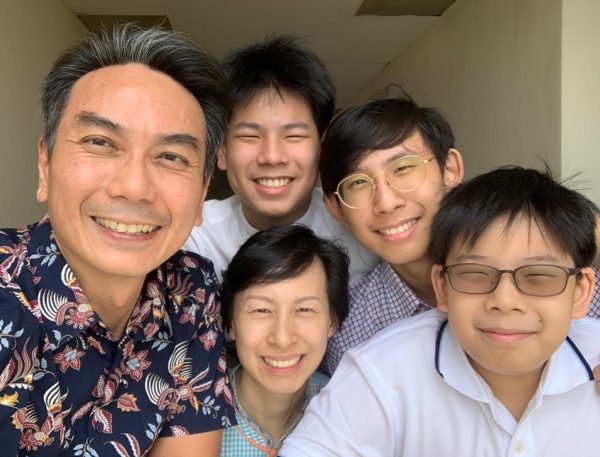
We are special parents too. Just like some of you, my husband Frankie and I have had our challenges in handling our second son who was diagnosed with Attention Deficit Hyperactivity Disorder (ADHD) and Dyslexia when he was 6 years old. He was also subsequently diagnosed with Autism Spectrum Disorder at age 10.
We believe that building our marriage on mutual understanding and making effort in communicating honestly has helped us cope as special parents. Despite differences in opinions and parenting styles, we make time to talk through things often. We share our own feelings and struggles regarding the situation, while we work at improving things together. Being united as a couple and helping the family synergize together to meet each other’s needs helps us overcome the challenges and demands of special parenting.
Parents are indeed the best people to help create the environment for our special children to thrive. It’s important also for parents to find ways to connect with other parents who are going through a similar journey. The natural affinity borne through the familiarity of similar family struggles and experiences creates a positive identification that helps you feel less alone in your journey.
In special families, it often becomes necessary that one parent stays home to help manage the special needs child and the home. Many families have found that the financial sacrifices are small in comparison to having one parent more present to manage the home full time.
In our case, we are glad that we chose for me to be a stay-home mum to all our 3 children even before our second child’s special needs was diagnosed. This helped us attend to the issues and be the main caregivers from day one. Our children have also come to appreciate this and know that we prioritise them above our own careers.
Special parenting is a transformational journey for us as parents. We need to constantly learn, re-learn, strategise and be creative in problem solving. Flexibility and humility are also so important. When you think of it with a growth mindset, you can find the gems in the journey and appreciate the learning that it brings to the whole family.
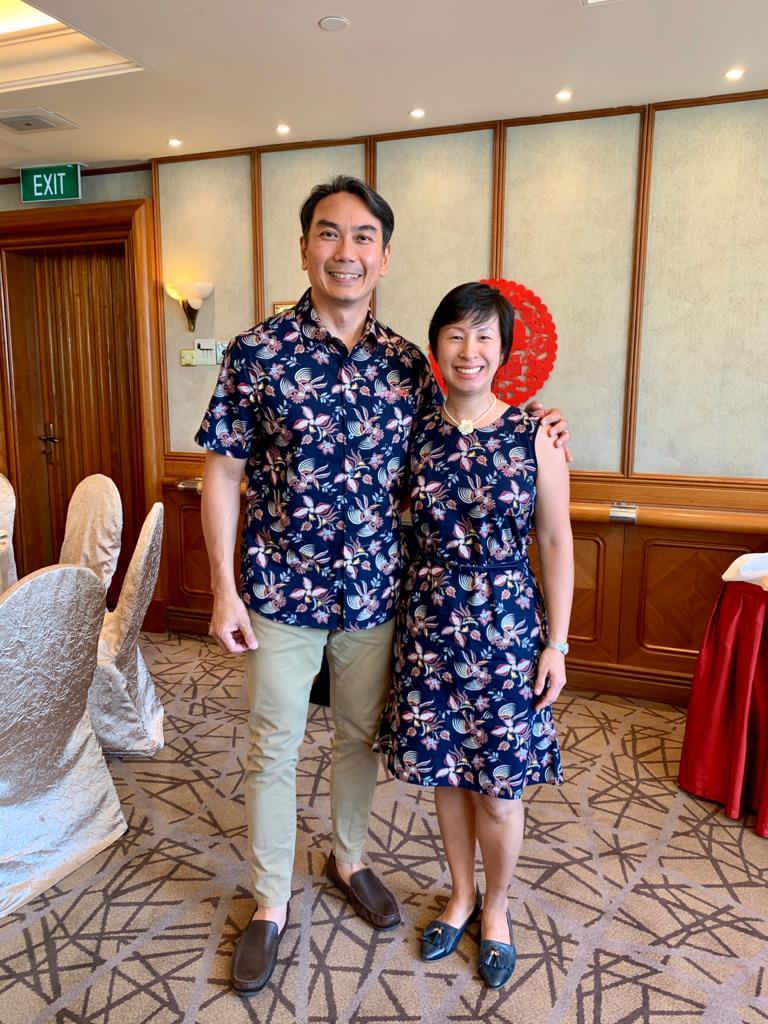
About Dr Frankie Tan and Tina Tan
Frankie and Tina are parents of 3 boys. Their second son has ADHD, Dyslexia and ASD, and their youngest son is also currently struggling with severe anxiety issues. Tina is a stay-home mum while Frankie holds a Ph.D. in Sport Science & Physiology and works at the Singapore Sport Institute. Both are active volunteers with various community groups like SPARK, Schools, SAFRA, Dads for Life, and in their church. Being active volunteers have truly enriched their lives as they reach out and support other families in similar situations as them.
To be updated on CaringSG’s latest events and join your preferred caregiver support groups in our CaringSG Alliance Network (CAN), sign up as a CaringSG member and let us know your preference!

On 25th October 2025, Singapore came together for a truly inspiring celebration of unity and inclusion at Purple Parade 2025.
Lead and execute communication strategies to strengthen CaringSG’s visibility, credibility, and engagement with caregivers, partners, and the public.
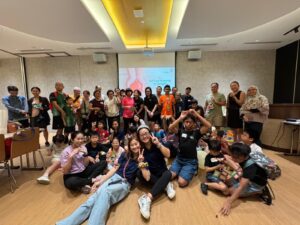
On 31st August 2025, a total of 56 CaringSG members — caregivers and their loved ones with physical, intellectual, and neurological impairments — came together at NTUC Club’s multipurpose hall, Singpost Centre to celebrate the last day of August with a BIG Sports and Wellness Bang!
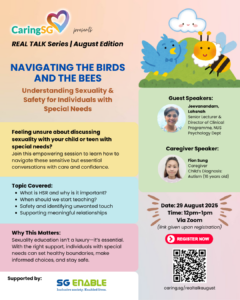
Teaching children about sexuality and healthy relationships is never an easy task, and for parents of children with intellectual disabilities and autism spectrum disorder (ASD), the challenges can feel even more overwhelming. To support caregivers on this journey, CaringSG recently hosted a webinar featuring expert insights and heartfelt sharing from both a professional and a parent, offering practical guidance, reassurance, and hope.

On 11 August 2025, 62 participants — including caregivers, persons with disabilities (PwDs), and their family members and loved ones, volunteers and CaringSG team — came together for a memorable SG60 celebration at Bird Paradise, Mandai.

On 3 August 2025, CaringSG proudly joined the nation in commemorating Singapore’s 60th birthday at the National Day Istana Open House (NDIOH).
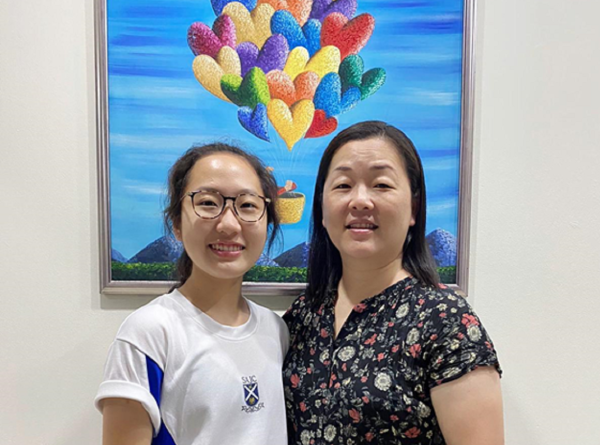
When Christina’s younger daughter, Edena (then 6), was diagnosed with dyslexia in 2009, she was determined to look for an intervention programme that could help her catch up with her reading age within the shortest time possible. She and her husband also decided to defer Edena’s Primary 1, as they saw how low her confidence was. They wanted to do what they could to give her the necessary interventions before the demands of the mainstream curriculum overwhelmed her.
Christina found the solution in the Davis Dyslexia Correction Programme (DDCP), a holistic approach to correcting dyslexia developed by Ronald D. Davis. He is also author of the books, The Gift of Dyslexia and The Gift of Learning. Being autistic and dyslexic himself, Ron figured out how to overcome his severe dyslexia and taught himself to finally read and enjoy a book without struggling at the age of 38. Ron subsequently opened a centre in California in 1982 to help children and adults overcome their learning difficulties.
The DDCP is an individualised, one-to-one correction programme given on an intensive schedule over 30 hours by a Davis Facilitator. It adopts a strength based approach by working with what a dyslexic can do, as opposed to what they cannot. Christina witnessed Edena’s transformation, going from hardly recognizing most words taught to being able to read a short paragraph by the end of the programme. This has not only met but exceeded Christina’s expectations.
For the next one year, Christina continued working with Edena using the Davis tools and techniques. By the time Edena returned to school a year later, she had a new found confidence. Now 17, Edena is pursuing her studies in junior college. This would not have been possible if not for the timely intervention and support from family, teachers and friends.
The journey from suspecting that Edena might have some learning difficulties, to seeking out professionals for advice, to researching and selecting the intervention programme, had been a daunting but enriching experience. While Christina has the desire to help other parents in similar situations, it is her conviction that to be in a position to provide guidance and support to other parents, she needs to have gone through the experience, successfully remediated the problem and be sufficiently well versed with the subject matter.
Hence she decided to dive into special needs education, first completing a Diploma in Disability Studies and later getting trained as a Davis Facilitator. Christina subsequently set up a Dyslexia Group on Facebook, with the mission to create more awareness about dyslexia and to help parents navigate their journey.
Contrary to what most people think, Christina shares that dyslexia is not a complexity but a combination of a few factors that can be tackled step by step. She explains that the symptoms of dyslexia are actually symptoms of disorientation. Disorientation is a state of mind where mental perceptions are not in agreement (i.e. distorted) with the true facts and conditions in the environment. When a dyslexic is sufficiently confused, he will react by disorientating spontaneously, thereby leading to perceptual distortion which results in mistakes made when reading, spelling or writing. Dyslexics therefore need a way to ‘turn off’ the disorientation at will.
But what caused the confusion? Basically, when a dyslexic encounters certain symbols, and all words are symbols (as are alphabet, punctuation marks, speech sounds, math symbols and numerals), they get confused by those symbols whose meaning they cannot picture. Dyslexics tend to think primarily in pictures, as opposed to thinking in words. Because of the way they think, whenever they come across symbols whose meaning they cannot picture, confusion sets in and once that threshold for confusion is reached, they will disorientate and mentally move around to ‘see’ from different viewpoints and angles in order to figure out what that symbol is.
To illustrate, take for example a simple math question – subtract 20 from 100. The majority of children can easily tackle this question, but not so straightforward to a dyslexic. High frequency or common sight words such as ‘from’, ‘by’, ‘the’, ‘if’, etc often caused confusion for dyslexics as they cannot picture the meaning of these words. A child may be able to recognise and pronounce the word ‘from’, but if he does not know the meaning, he would not know how to begin solving the math problem.
After much drilling and repetition to no avail to help the child understand the question, the child is then told by a well-meaning parent or tutor that whenever he sees such questions, he just needs to minus the smaller number with the bigger number. In so doing, the child is taught rote learning, rather than have real understanding or true mastery of the subject.
To resolve the confusion with the word ‘from’, the child needs to master the word in all its three parts ie what the word means (a picture representing the concept/idea of the meaning), what it looks like (the spelling of the word) and how it sounds (the pronunciation of the word). Once the child masters the word ‘from’, which means ‘starting with, beginning at’, the child can now think with the words in the question. So subtract 20 from 100 means he has to start with, begin at (ie from) 100, and then take away 20. Visually, he would be able to put 100 down on paper, followed by the minus sign and 20 below 100 and then do his workings to get to the answer.
There are 219 high frequency words that typically trigger disorientation for a dyslexic. These non-picture words make up about 75% of words on a page. By mastering these trigger words, the source of confusion will be eliminated and they will not trigger disorientation. Therefore, when we remove the reason why a problem exists, the problem ceases to exist!

To be updated on CaringSG’s latest events and join your preferred caregiver support groups in our CaringSG Alliance Network (CAN), sign up as a CaringSG member and let us know your preference!

On 25th October 2025, Singapore came together for a truly inspiring celebration of unity and inclusion at Purple Parade 2025.
Lead and execute communication strategies to strengthen CaringSG’s visibility, credibility, and engagement with caregivers, partners, and the public.

On 31st August 2025, a total of 56 CaringSG members — caregivers and their loved ones with physical, intellectual, and neurological impairments — came together at NTUC Club’s multipurpose hall, Singpost Centre to celebrate the last day of August with a BIG Sports and Wellness Bang!

Teaching children about sexuality and healthy relationships is never an easy task, and for parents of children with intellectual disabilities and autism spectrum disorder (ASD), the challenges can feel even more overwhelming. To support caregivers on this journey, CaringSG recently hosted a webinar featuring expert insights and heartfelt sharing from both a professional and a parent, offering practical guidance, reassurance, and hope.

On 11 August 2025, 62 participants — including caregivers, persons with disabilities (PwDs), and their family members and loved ones, volunteers and CaringSG team — came together for a memorable SG60 celebration at Bird Paradise, Mandai.

On 3 August 2025, CaringSG proudly joined the nation in commemorating Singapore’s 60th birthday at the National Day Istana Open House (NDIOH).
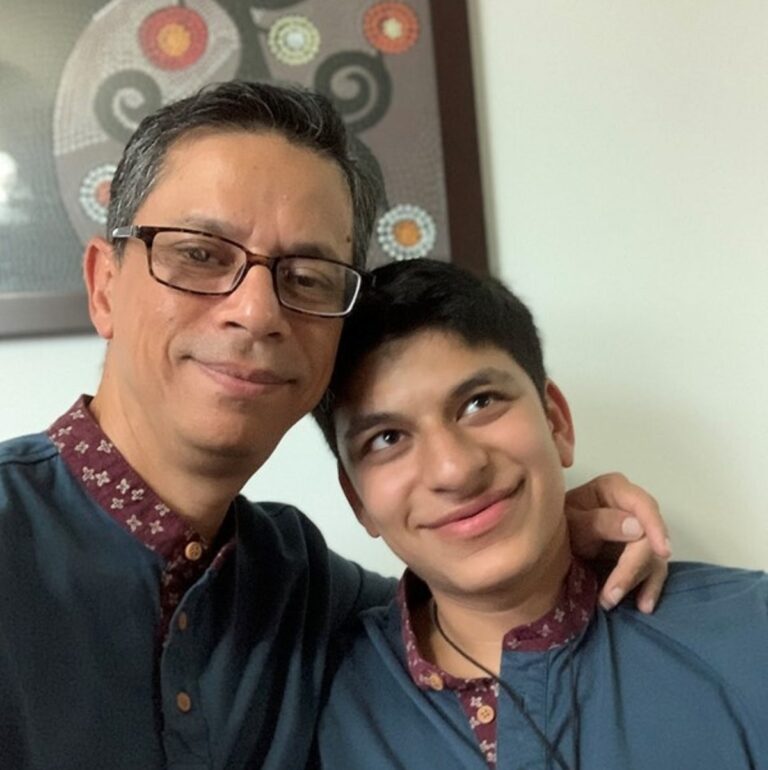
I’m a special dad. For 14 years, I’ve walked through the journey you’re experiencing now.
The thing is that no one really tells you what to do, and old school men like me don’t really ask because we feel we have the responsibility of being the provider of the family come what may.
You may be starting to accept your child’s diagnosis, or searching for elusive answers with Google. But nothing can help you as much as being with other special dads, knowing you’re not the only one trying to make sense of the turbulence ahead.
As one special dad to another, this is what I think you should prepare for.
1. Planning Finances
Having a special needs child can mean redesigning our whole life for therapy schedules, doctor visits, tests and other related appointments.
Besides the financial strain due to these extra costs, some special dads (or our wives) have to give up career progression or quit altogether to accompany our child to appointments.
Suddenly we have a double whammy — higher expenses and lower household income.
In my earlier years, I had held fast to some simple accounting principles of ensuring I invested and diversified the money I earned. I left the purchase of cars, clothing and holidays to a later date because I had an extended family that impressed upon me on what I needed to do when I grew up.
Today we have the internet, financial consultants, and even government portals such as MoneySense to advise the best for our needs at different stages of our lives. I would encourage you to reach out and use these avenues so that we can educate ourselves enough to be able to help our families.
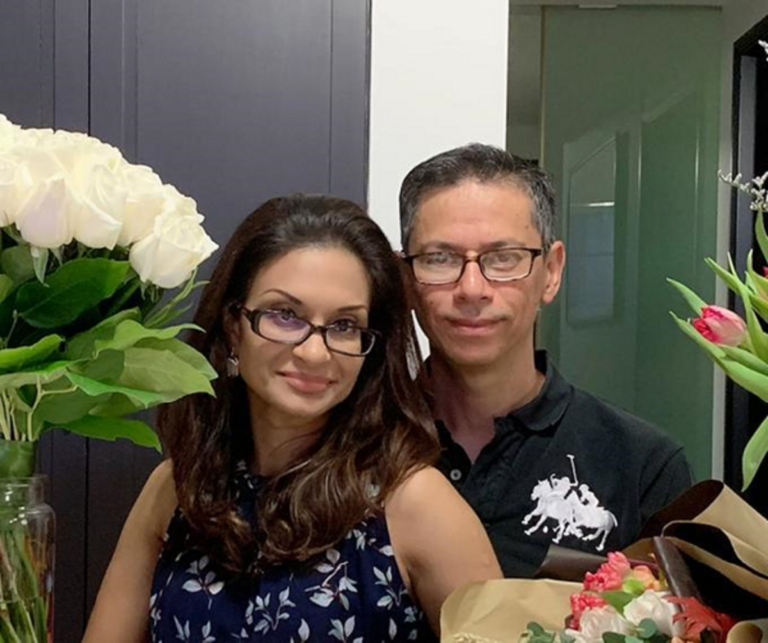
2. Managing wife’s expectations
There will be days where your relationship with your wife may become strained due to the stress of caring for your special needs child.
Not everything has to be an equal game. Everyone has strengths at different points of time.
Look at things objectively. If your wife is in a better position to put bread on the table, could you step up and be a hands-on father to your special needs child? This is what I decided to do five years ago when my son grew bigger and needed a more present father.
Our marriage is still a “work in progress”. We deal with challenges and each other’s sensitivities the best we can. There are so many permutations to getting it to work and there is no “best” or “logical process” to make it work. Every day presents new challenges and opportunities.
I’ve learned that no matter how angry, sad, disappointed or let down I feel, I don’t need to take it to heart, and I try my best to be empathic. Even this may not work all the time, so I then take it as life’s journey. We can still choose to see how we can make things work better and learn from the experience.
This makes for a happier “me”, and a happier “me” can then back down, smile and not let the situation escalate further unnecessarily.
3. Do I have to solve everything?
We men have an innate habit of going into problem-solving mode. But special needs isn’t something you can cure away.
That said, there are some things that you can solve, such as planning ahead, creating a safe space for your family to walk this journey together, and spending time on self-care for yourself.
For everything else that is out of your hands, learn how to adjust and outsource to experts. For example, Centre For Fathering runs programmes for fathers on parenting and adventure camps to promote bonding with your child.
4. Be prepared to start from ground zero
As we learn from scratch how to become a father when our first child is born, we also start from ground zero when we first realise we are special needs dads.
Centre For Fathering has a growing community of special needs dads who have walked in your shoes and know what it’s like.
Find your tribe and take it step by step.

5. Making the best of what we have
When life throws us lemons, make lemonade.
Being a special dad ironically came with blessing to me. I discovered I have so many untapped skills as a father and that our special child brings out in us.
In my years of being a father, I feel I was accorded the privilege of being a father to a special needs child simply because my son has made me a more resilient, patient, emotionally connected father. This is something I wasn’t always (and to a large degree) felt capable of doing.
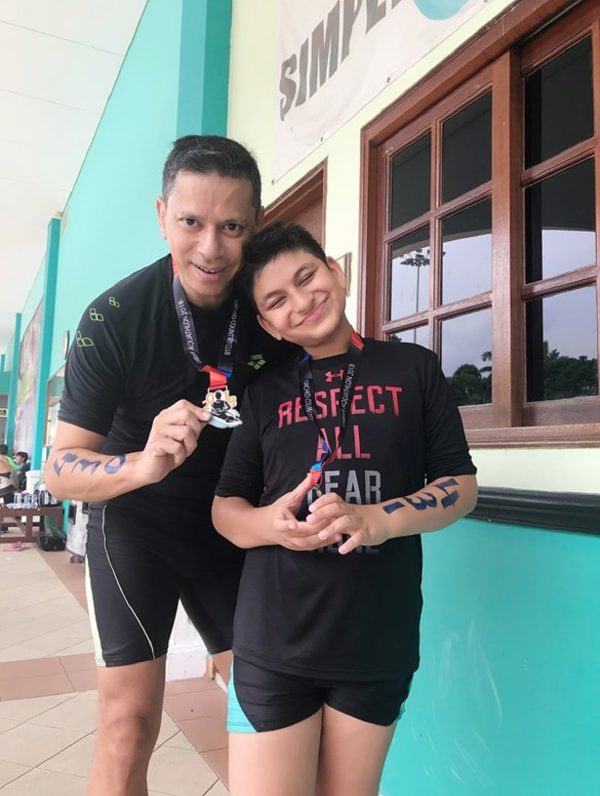
About Anand Lal and the Centre For Fathering’s Special Dads Group:
Anand Lal is a special dad to a fourteen-year old son with intellectual disabilities and apraxia. He quit his full-time job five years ago to spend more time with his son, such as taking him on adventure trips and indulging in swimming, his favourite activity. Anand has also upgraded his skills to become an Inclusive and Neuro Diverse Water Safety and Swimming Coach, and actively volunteers at the Centre For Fathering’s Special Dads Group.
Anand is also a CaringSG CAREconnect champion and is the Head of CAREbuddy.
All photos courtesy of Anand Lal.
To be updated on CaringSG’s latest events and join your preferred caregiver support groups in our CaringSG Alliance Network (CAN), sign up as a CaringSG member and let us know your preference!

On 25th October 2025, Singapore came together for a truly inspiring celebration of unity and inclusion at Purple Parade 2025.
Lead and execute communication strategies to strengthen CaringSG’s visibility, credibility, and engagement with caregivers, partners, and the public.

On 31st August 2025, a total of 56 CaringSG members — caregivers and their loved ones with physical, intellectual, and neurological impairments — came together at NTUC Club’s multipurpose hall, Singpost Centre to celebrate the last day of August with a BIG Sports and Wellness Bang!

Teaching children about sexuality and healthy relationships is never an easy task, and for parents of children with intellectual disabilities and autism spectrum disorder (ASD), the challenges can feel even more overwhelming. To support caregivers on this journey, CaringSG recently hosted a webinar featuring expert insights and heartfelt sharing from both a professional and a parent, offering practical guidance, reassurance, and hope.

On 11 August 2025, 62 participants — including caregivers, persons with disabilities (PwDs), and their family members and loved ones, volunteers and CaringSG team — came together for a memorable SG60 celebration at Bird Paradise, Mandai.

On 3 August 2025, CaringSG proudly joined the nation in commemorating Singapore’s 60th birthday at the National Day Istana Open House (NDIOH).